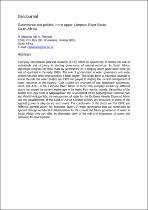JavaScript is disabled for your browser. Some features of this site may not work without it.
- ResearchSpace
- →
- Research Publications/Outputs
- →
- Journal Articles
- →
- View Item
| dc.contributor.author |
Meissner, Richard

|
|
| dc.contributor.author |
Ramasar, V

|
|
| dc.date.accessioned | 2016-07-11T10:59:42Z | |
| dc.date.available | 2016-07-11T10:59:42Z | |
| dc.date.issued | 2015-10 | |
| dc.identifier.citation | Meissner, R and Ramasar, V. 2015. Governance and politics in the upper Limpopo River Basin, South Africa. GeoJournal, Vol 80(5), pp. 689-709 | en_US |
| dc.identifier.issn | 0343-2521 | |
| dc.identifier.uri | http://hdl.handle.net/10204/8637 | |
| dc.description | Copyright: 2015 Springer Verlag.Due to copyright restrictions, the attached PDF file only contains the abstract of the full text item. For access to the full text item, please consult the publisher's website. For access to the full text item, please consult the publisher's website. The definitive version of the work is published GeoJournal, Vol 80(5), pp. 689-709 | en_US |
| dc.description.abstract | Everyday international political economy (EIPE) offers an opportunity to rethink the role of individuals and citizenry in shaping governance of natural resources. In South Africa, significant progress has been made by government in re-shaping water governance since the end of apartheid in the early 1990s. The role of government in water governance and water politics has thus been emphasised to a large degree. This study looks at historical material to assess the role that water politics and EIPE has played in shaping the use and management of water resources in the country. Case studies are analysed of two quaternary catchments, A63E and A71L in the Limpopo River Basin, to show how everyday actions by different actors has shaped the current waterscape in the basin. Four events, namely, the politics of the Middle Iron Age State at Mapungubwe; the development of the Mapungubwe National Park and World Heritage Site; the management of water for the De Beers Venetia Diamond Mine; and the establishment of the Coal of Africa Limited colliery are discussed in terms of the agential power at play during each event. The conclusions of the study are that EIPE and reflexive agential power are important factors in water governance that can sometimes be ignored through neoliberal institutionalism. In the current and future governance of water in South Africa they can offer an alternative view of the role and importance of actors and pathways for development. | en_US |
| dc.language.iso | en | en_US |
| dc.publisher | Springer Verlag | en_US |
| dc.relation.ispartofseries | Workflow;14962 | |
| dc.subject | Water governance | en_US |
| dc.subject | Natural resources governance | en_US |
| dc.subject | Limpopo River | en_US |
| dc.subject | Quaternary basin | en_US |
| dc.subject | Mapungubwe | en_US |
| dc.title | Governance and politics in the upper Limpopo River Basin, South Africa | en_US |
| dc.type | Article | en_US |
| dc.identifier.apacitation | Meissner, R., & Ramasar, V. (2015). Governance and politics in the upper Limpopo River Basin, South Africa. http://hdl.handle.net/10204/8637 | en_ZA |
| dc.identifier.chicagocitation | Meissner, Richard, and V Ramasar "Governance and politics in the upper Limpopo River Basin, South Africa." (2015) http://hdl.handle.net/10204/8637 | en_ZA |
| dc.identifier.vancouvercitation | Meissner R, Ramasar V. Governance and politics in the upper Limpopo River Basin, South Africa. 2015; http://hdl.handle.net/10204/8637. | en_ZA |
| dc.identifier.ris | TY - Article AU - Meissner, Richard AU - Ramasar, V AB - Everyday international political economy (EIPE) offers an opportunity to rethink the role of individuals and citizenry in shaping governance of natural resources. In South Africa, significant progress has been made by government in re-shaping water governance since the end of apartheid in the early 1990s. The role of government in water governance and water politics has thus been emphasised to a large degree. This study looks at historical material to assess the role that water politics and EIPE has played in shaping the use and management of water resources in the country. Case studies are analysed of two quaternary catchments, A63E and A71L in the Limpopo River Basin, to show how everyday actions by different actors has shaped the current waterscape in the basin. Four events, namely, the politics of the Middle Iron Age State at Mapungubwe; the development of the Mapungubwe National Park and World Heritage Site; the management of water for the De Beers Venetia Diamond Mine; and the establishment of the Coal of Africa Limited colliery are discussed in terms of the agential power at play during each event. The conclusions of the study are that EIPE and reflexive agential power are important factors in water governance that can sometimes be ignored through neoliberal institutionalism. In the current and future governance of water in South Africa they can offer an alternative view of the role and importance of actors and pathways for development. DA - 2015-10 DB - ResearchSpace DP - CSIR KW - Water governance KW - Natural resources governance KW - Limpopo River KW - Quaternary basin KW - Mapungubwe LK - https://researchspace.csir.co.za PY - 2015 SM - 0343-2521 T1 - Governance and politics in the upper Limpopo River Basin, South Africa TI - Governance and politics in the upper Limpopo River Basin, South Africa UR - http://hdl.handle.net/10204/8637 ER - | en_ZA |






